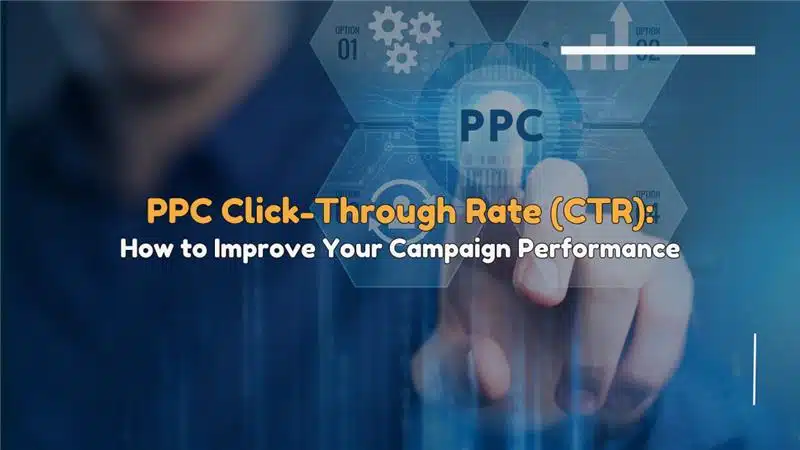Click-through rate (CTR) isn’t just any number. CTR tells a tale—it shows us how grabbing your ad is, how well it fits your main crowd, and if it truly drives them to act. At its heart, CTR is the share of folks who click on your ad once they see it. A significant CTR means your ads are not just seen, but are also making a mark.
But there’s a snag here—not every CTR is the same. What’s viewed as a “good” CTR changes a lot based on your work area, how your ad looks, and what platform you use. For one type of job, a 5% CTR might be great, but for another, it could show weak results. This change makes it hard for companies to measure their success.
In this post, we’ll unfold what CTR means in PPC marketing and look at how this key number moves across different fields. Whether you’re running Google Search ads, Display Network ads, or using paid social media plans, we’ll share top ways to boost your CTR and lift your overall ad results. Ready to make your ads more click-friendly? Let’s jump in.
What Is Click-Through Rate (CTR) and Why Does It Matter?
We find the Click-Through Rate by taking the number of hits your ad gets, dividing by how many times it’s shown, and then multiplying that by 100. Say, if your ad appears 1,000 times and gets 30 hits, your CTR is 3%.
While it’s easy to figure out, the meaning is profound. A higher CTR mostly shows that your ad hits the mark and engages your people. Tools like Google Ads even give higher CTRs and better Quality Scores, which can mean lower costs per click and better ad spots.
Above all, CTR is an early sign of how well your offers, messages, and designs appeal to the target group. Basically, CTR answers this big question: Are your ads catchy enough to get a click?
CTR Benchmarks: Why They Vary Across Industries
Note that not all fields are the same when we talk about what CTRs they expect. For instance, dating and personal services very often see CTRs of more than 6%, due to the strong feelings and urgent needs linked with the service. Travel and hotel groups see high CTRs because of strong image appeal and timely needs.
On the other hand, fields like tech and B2B services tend to see lower CTRs, often just over 2%. This is usually because their people need more time, do more research, or need more warm-up before hitting on an ad.
In real estate, you can expect both your search and display CTRs to be above average, especially if you use top-notch images and focus on location. Education, finance, and health care fields also tend to pull in good CTRs because they are key and draw broad interest, but don’t expect every ad to perform the same.
On another note, eCommerce, while full of competition, often sees mid-range CTRs. Users are hit based on price, product looks, and time needs, so marketers have space to try things like time-limited sales, free shipping offers, and short discounts.
Bottom line? Your field sets the rules. Rating your CTR against all others without context could lead your plan off track. Instead, match your results with well-known benchmarks in your field.
Read More: Get More Leads with Pay-Per-Click
Factors That Influence Your CTR
While your type of work is a big part of your CTR, it’s not the only thing that matters. How you target, your ad words, and even your platform choice can shape your campaign’s pull rate.
Search ads often get better CTRs than display ads. Why? Because the need to search is strong, people are out there looking for something specific. On the flip side, display ads are more passive; they pop up while people are browsing, so your ad needs to work harder to get noticed.
Another significant point is your choice of keywords. Sharp, specific keywords often convert better and bring higher CTRs, while broad ones may get lots of views but few hits.
Ad relevance is key, too. Google, for one, checks how well your ad matches what people are looking for. The closer your ad is to their needs, the higher your Quality Score—and the better your CTR.
Don’t overlook brand power, either. Well-known names naturally bring more trust, leading to more hits. Start-ups and lesser-known groups need to build trust with steady branding, good reviews, and strong calls-to-action.
Strategies to Improve Your CTR
To raise your CTR, start by knowing your audience’s thoughts. What issue do they have? What words do they like? When you understand their goal, you can make your ads better from the core.
Start with keyword targeting. Pick key, strong words that show the user’s stage in their buy path. Use bad words to block out wrong visits and get better at picking over time.
Then, fix your ad text. Your titles should be clean, focus on perks, and touch the heart. Show what sets your deal apart—like a price cut, a short sale, or offers like “Free Talk” or “Get It Today.”
Ad extras also help a lot with your CTR. Options like links, notes, lists, and phone add-ons give people more choices and more reasons to click. They also take up more space in search findings, so your ad stands out more.
For ad shows, how it looks is key. Your image needs to be neat, in line with your brand, and bold. Match it with a firm offer and a clear call-to-action word. Also, be sure the page it links to shows the same message—this holds up both CTR and action after the click.
Don’t Overlook the Role of Landing Pages
Though not in the CTR mix, landing pages still affect how your ad does. If people click your ad but leave fast, that act can affect future views and clicks, mainly on platforms that encourage active use.
A top landing page should fit the tone, message, and offer of your ad. Check it loads fast, particularly on phones, and has one strong call-to-action. A mess, slow speeds, and intricate designs can cut down on real sales, even if your CTR is good.
Google and other places also think about the landing page feel when they figure out Quality Score. So, a not-so-good user thinks that after the click, your costs could rise even if your ad looks good at first.
How to Continuously Monitor and Improve CTR?
Fixing your CTR is a steady job. Don’t just set it and forget it. Keep an eye on it to know what does well and what needs fixing. Weekly checks find bad words or ad versions, while monthly checks let you dig into stats like share, leave rate, and sell rate.
Split your CTR by tool, place, time, and group parts. This data can show bad areas you might miss. For example, if your CTR on phones is always less than on computers, it may be time to look at your phone ad words or page response.
Line up your results not just with past times, but also with what others in your area do. Set tangible goals and shape your aims as your plans grow.
Final Thoughts
A good CTR is key to pay-per-click management ads that win. It shows your message is correct, your picking is tight, and your offer pulls people in. But recall, CTR alone doesn’t make cash. It’s the first click on a longer road toward a sale, and should be made better with that full path in mind.
By knowing how CTR shifts by area, tracking how you do often, and making smart fixes to your ads, you’ll be set to run ads that not just draw clicks, but turn those clicks into real profits.
At Eco York, we’re experts at making social media marketing and PPC ads that do more than just show and click—we bring tangible results that count. Let us lift your ad game and help your work grow with plans based on data.





